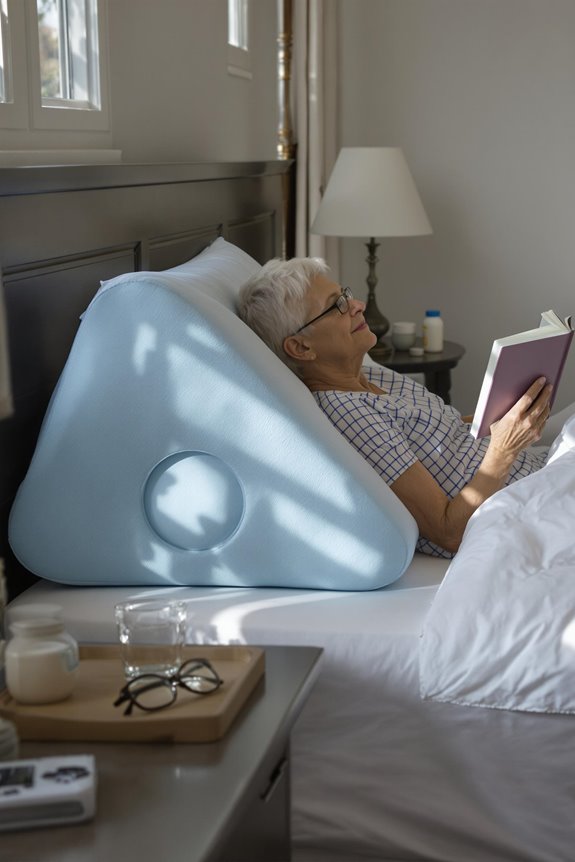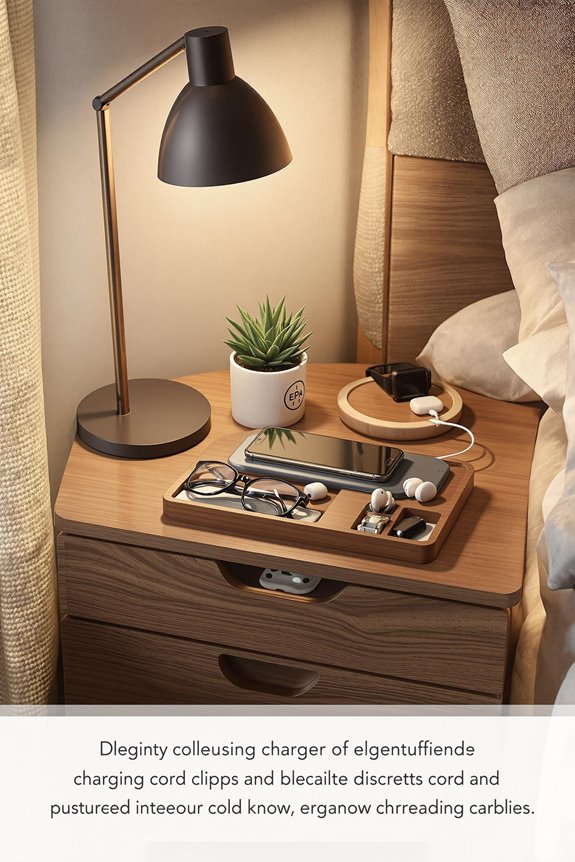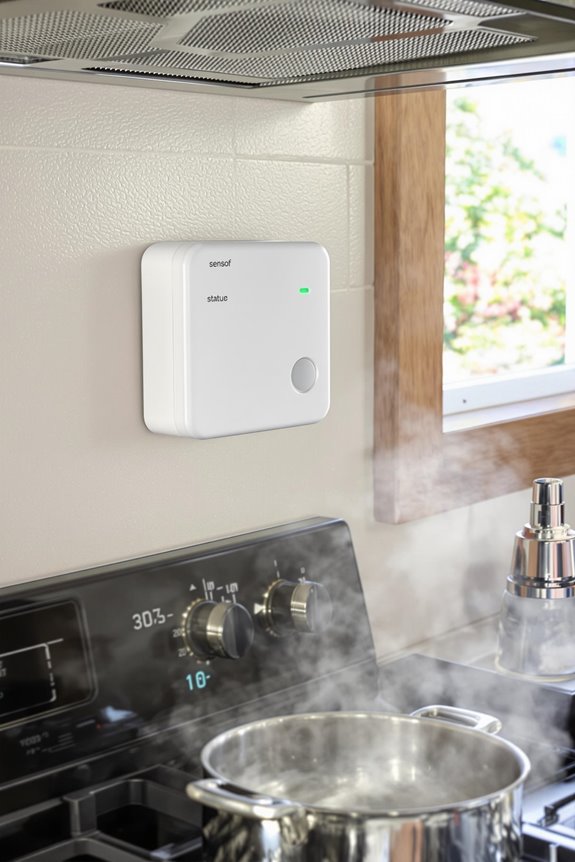Have you ever fumbled your way to the bathroom at night, bumping into furniture or stubbing your toe? Under bed motion lights offer a simple solution to this common problem. These unobtrusive devices automatically illuminate your path when they detect movement, providing just enough light to guide you safely without disturbing your partner or requiring you to turn on harsh overhead lights. The right motion-activated system can transform your nighttime routine and help prevent accidents.
Key Takeaways
- Under-bed motion lights automatically illuminate pathways to the bathroom without waking others or requiring wall switches.
- Installation requires mounting sensors 6-12 inches from the floor on both sides of the bed for optimal coverage.
- Warm light (2700-3000K) provides sufficient visibility while avoiding harsh brightness that disrupts sleep patterns.
- Prices typically range from $15-60, with basic models available around $20-30 and advanced models at $50-60.
- Systems require regular maintenance including monthly battery checks and bi-weekly sensor dusting for reliable operation.
Under Bed Motion Lights
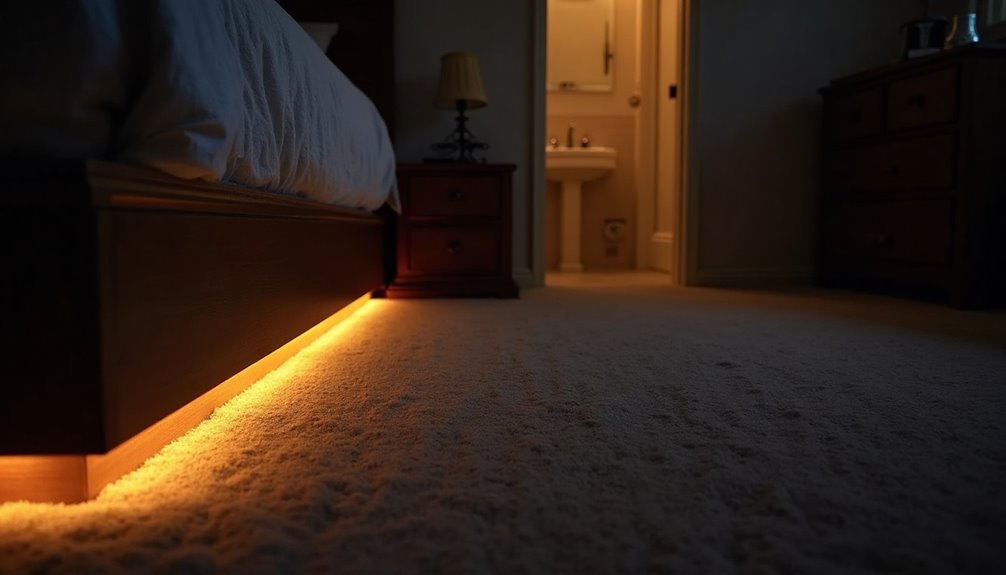
Nighttime steering becomes infinitely safer for aging parents with the simple addition of under bed motion lights. These affordable devices activate when feet hit the floor, illuminating the path to the bathroom without disturbing sleep patterns.
For seniors aging in place, proper installation is essential. Place sensors approximately 6-8 inches from the floor, ensuring coverage of high-traffic areas. The best models offer adjustable brightness levels, automatic shut-off timers, and flexible mounting options.
When choosing under bed motion lights for home safety, consider:
- Battery life (rechargeable preferred)
- Light color (warm tones are less jarring)
- Installation complexity
- Motion sensitivity range
These simple devices greatly enhance accessibility while preventing falls—a primary concern in maintaining your parents’ independence.
Costs typically range from $15-40, making them a cost-effective investment in comfort and safety.
What it is and the daily problems it solves
Let’s explore exactly what under bed motion lights are and why they’ve become such game-changers for seniors living independently.
These innovative devices are LED light strips that mount underneath the bed frame and automatically illuminate when they detect movement. When your parent gets up during the night, sensors activate soft, gentle lighting that illuminates the floor path without disturbing their partner or requiring them to fumble for a light switch.
Under bed motion lights address several critical nighttime challenges seniors face: reducing fall risks during bathroom trips, preventing disorientation in the dark, eliminating the need to navigate furniture obstacles blindly, and providing just enough light to see without fully waking up.
Many models feature auto-shutoff timers and adjustable brightness settings, making them practical solutions that enhance both safety and independence without complicated installation or maintenance.
Who benefits and when to use it
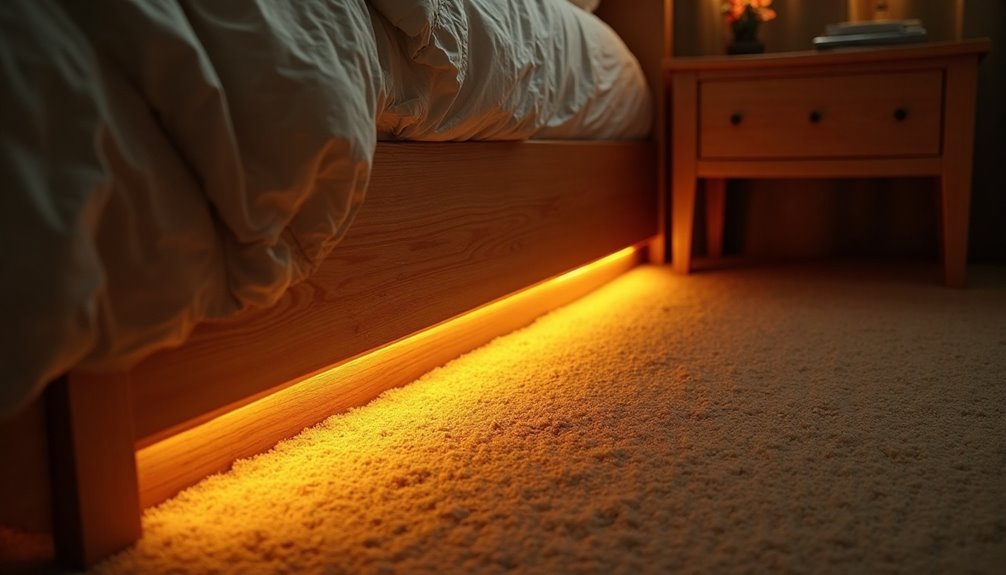
Almost anyone with aging parents who get up at night can benefit from under bed motion lights. These devices are especially valuable for seniors with mobility concerns, those who experience occasional disorientation, or anyone at risk of falling in the dark.
Consider installing these lights when your parents:
- Make frequent nighttime bathroom trips
- Have experienced falls or near-falls
- Express anxiety about moving around after dark
- Are recovering from surgery or illness
- Take medications that increase bathroom visits
The lights provide just enough illumination to navigate without disturbing sleep patterns or requiring wall switches.
They’re also helpful during power outages as a reliable pathway light that activates only when needed, offering both independence and safety with minimal intrusion into daily routines. Additionally, implementing solutions like holistic care approaches can further enhance their overall safety and well-being during nighttime activities.
Key features to look for
When shopping for under bed motion lights, you’ll want to focus on specific features that enhance both functionality and safety for your parents.
The right combination of features can make all the difference in preventing nighttime falls and providing peace of mind.
Let’s go through what to look for when selecting the best option for your loved one’s needs.
Feature checklist
Six essential features make the difference between a basic under-bed light and one that truly enhances your parent’s safety and independence.
When shopping for under-bed motion lights, focus on functionality that addresses your loved one’s specific needs rather than unnecessary bells and whistles.
- Motion sensitivity that detects movement from the bed (not just walking past), with adjustable settings for sensitivity range
- Auto shut-off timer options (30 seconds to 10 minutes) to conserve battery life
- Warm light (2700-3000K) that illuminates without causing glare or harsh brightness
- Simple installation with adhesive strips that won’t damage furniture or require tools
- Integration with smart home technologies can further enhance safety and provide peace of mind for caregivers.
How to choose the right under bed motion lights
Choosing the right under bed motion lights for your senior parents can make a significant difference in their nighttime safety and independence. When selecting these lights, focus on sensitivity settings that activate with minimal movement, ensuring they illuminate before your loved one is fully out of bed.
Look for models with adjustable brightness to provide sufficient light without being harsh or disorienting. Consider battery life and installation requirements—some units offer rechargeable options while others require hardwiring.
The light color matters too; warm amber tones are less likely to disrupt sleep patterns than bright white or blue lights. For ideal coverage, measure the area from the bed to the bathroom door, and choose lights with appropriate range.
Many seniors prefer models with automatic shut-off timers to conserve power and prevent the need for manual operation.
Placement or installation basics
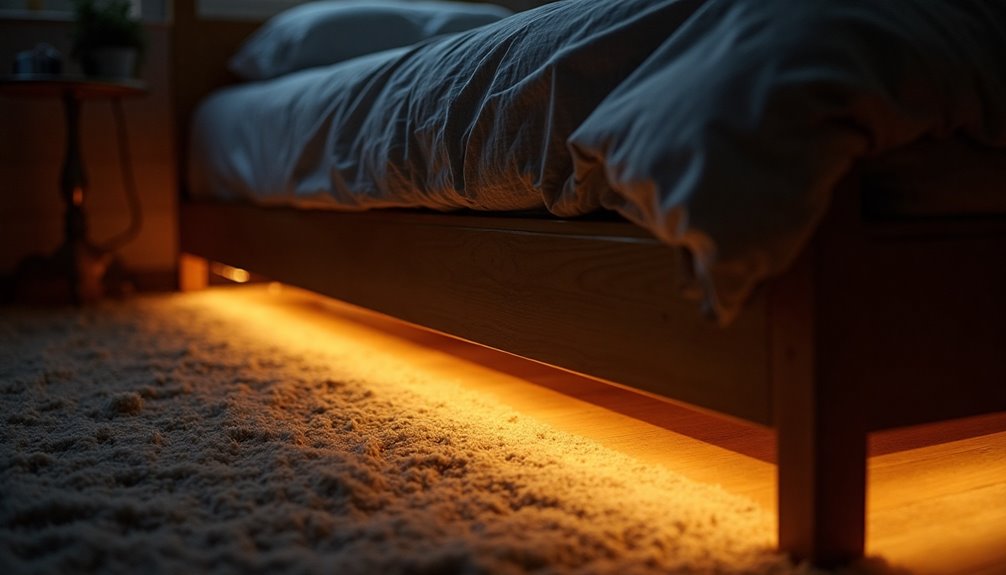
The three keys to effective under bed motion light placement focus on accessibility, coverage, and practicality.
Install sensors on both sides of the bed for ideal coverage, positioning them about 6-12 inches off the floor. Verify the sensors aren’t blocked by bedding, furniture, or storage boxes that might obstruct detection.
For proper function, keep the area beneath the bed relatively clear, allowing the sensors to detect movement effectively. Most units come with adhesive backing, making installation quick without tools or wiring expertise.
Some models include adjustable sensitivity controls—start with medium sensitivity, then adjust based on performance.
Remember to test the lights after installation by getting in and out of bed several times, making adjustments until the timing and coverage meet your loved one’s specific needs and walking patterns.
Setup steps
Setting up under-bed motion lights involves five straightforward steps that anyone can complete in about 15 minutes.
First, unbox your lights and check that all components are present, including sensors, light strips, and power source.
Second, clean the area where you’ll mount the sensors, ensuring surfaces are dust-free for proper adhesion.
Third, position the light strips under the bed frame, typically 2-3 inches from the edge for ideal coverage.
Fourth, mount the motion sensors at the proper height—usually 6-12 inches from the floor—pointing toward walking paths.
Finally, connect the power source, either by installing batteries or plugging into a nearby outlet, then test the system by walking past the sensors in low light conditions to verify proper activation.
Costs and warranties
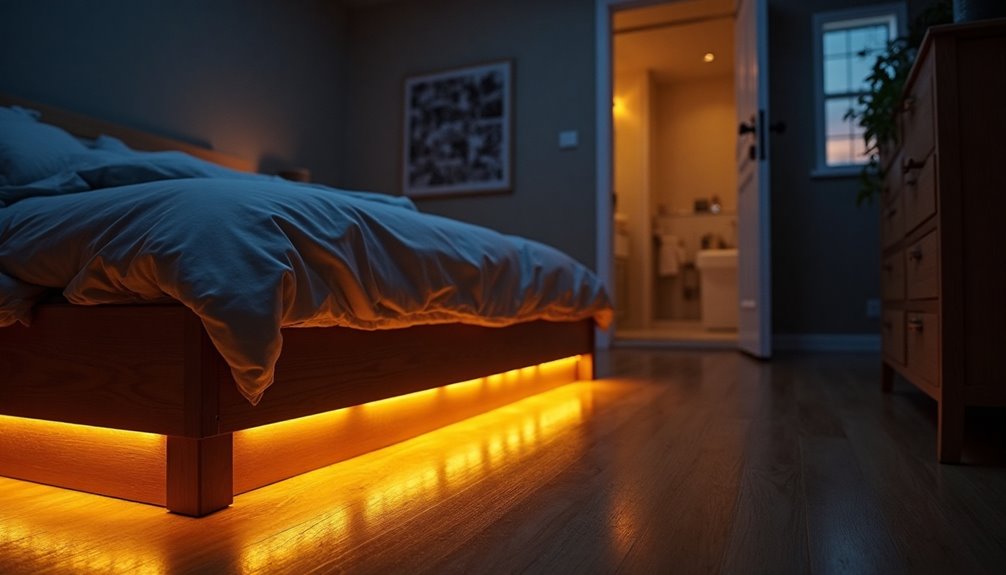
You’ll find that under bed motion lights are quite affordable for the safety they provide, typically ranging from $15 to $60 depending on the features and quality.
The budget-friendly options around $20-30 usually offer basic motion detection with standard LED strips, while spending closer to $50-60 gets you advanced features like adjustable sensitivity, multiple color options, and longer battery life.
When planning your purchase, consider not just the initial cost but also whether replacement parts are available and if the warranty covers both the sensor mechanism and the light strip components.
Example budget
When planning for under bed motion lights, understanding the costs and warranty options helps you make informed decisions without breaking the bank. Creating a realistic budget guarantees you get reliable lighting without unnecessary expenses.
| Item | Typical Cost Range |
|---|---|
| Basic motion sensor light | $15-30 |
| Premium sensor system | $40-80 |
| Rechargeable batteries | $10-25 |
Most homeowners can outfit a standard bedroom setup for under $50 with basic models that include a one-year warranty. For multiple rooms, consider purchasing multipacks which typically offer a 10-15% discount. Remember to factor in replacement batteries if choosing non-rechargeable options, as this recurring cost adds up over time. Some premium systems include extended warranties up to three years, providing additional peace of mind for a modest price increase.
Daily use and upkeep
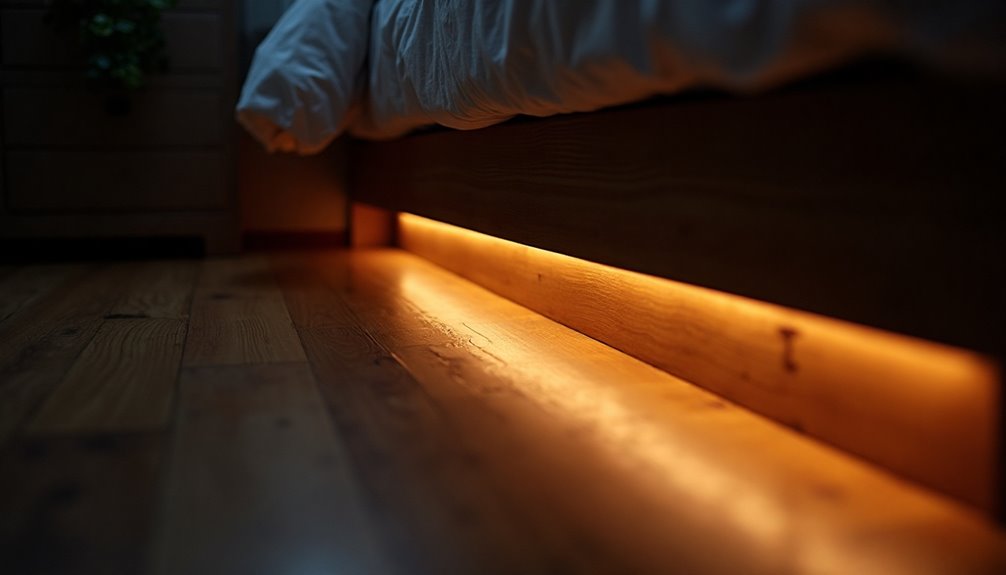
Maintaining under bed motion lights properly guarantees they’ll function reliably when your parents need them most. Most systems require minimal upkeep, but a consistent routine helps extend their lifespan.
Check batteries monthly, replacing them before they’re completely drained. For rechargeable models, follow the manufacturer’s guidelines on charging cycles.
Dust can accumulate around sensors, potentially affecting motion detection. Simply wipe the units with a dry microfiber cloth every two weeks. Avoid using liquid cleaners that might damage electronics.
Periodically test the lights by walking past them in darkness to verify they’re activating properly. If sensitivity seems reduced, check the sensor direction and adjust as needed.
For hardwired systems, inspect connections annually to confirm they remain secure and undamaged.
Safety tips and mistakes to avoid
Proper maintenance sets the foundation for safety, but let’s focus on specific precautions that protect your parents from potential hazards.
First, verify all cables are properly secured to prevent tripping. Don’t place lights where they might create confusing shadows or glare. Position them to illuminate pathways without shining directly into your parent’s eyes when they’re in bed.
Avoid using lights that are too bright, as these can be disorienting when someone wakes from deep sleep. Instead, choose warm-toned lights with moderate brightness.
Never block emergency exits with furniture positioned to accommodate light sensors. Remember that under-bed lights complement, but don’t replace, proper night lights in bathrooms and hallways.
Regularly test the motion sensors to confirm they’re activating appropriately, especially after changing batteries or cleaning the units.
Alternatives and when not to use this product
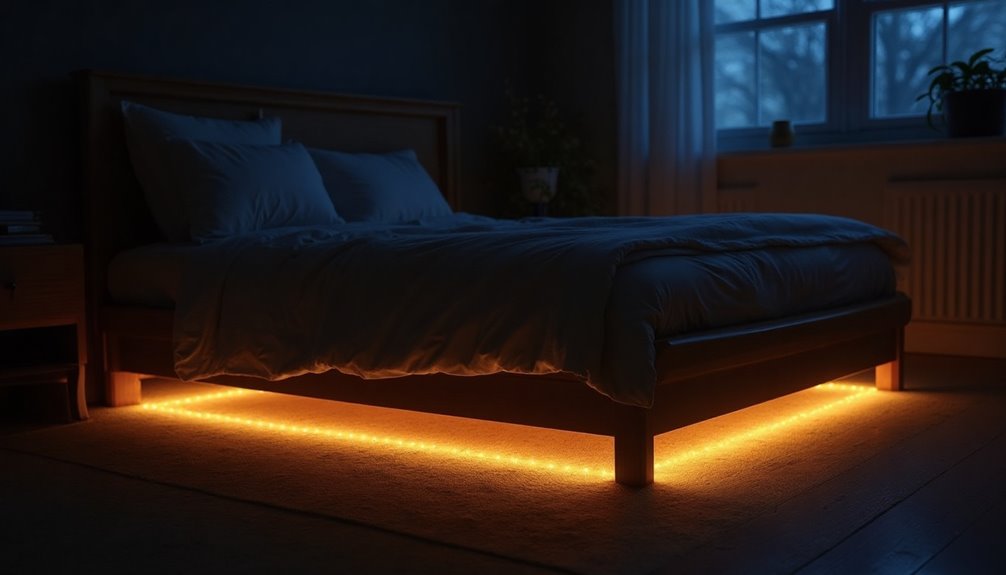
Though under-bed motion lights offer excellent support for many seniors, they aren’t always the right solution for every situation.
While under-bed motion lights help many older adults, they aren’t universally ideal for every senior’s specific needs.
If your parent has cognitive impairments like dementia, the sudden lighting may cause confusion or startlement, potentially increasing fall risk.
Alternative solutions include:
- Plug-in nightlights with dusk-to-dawn sensors
- Battery-operated touch lamps on bedside tables
- Light switches with illuminated plates
- Voice-activated lighting systems
- Full bedroom motion sensors that provide gentler, wider illumination
Skip under-bed lighting when:
- Your parent is sensitive to light while sleeping
- There are pets that might trigger the sensors constantly
- You need more extensive lighting for larger spaces
- Better solutions like grab bars and proper pathway lighting would address safety concerns more effectively
FAQs
When it comes to under-bed motion lights, families often ask me similar questions during our home safety evaluations.
Here are answers to the most common inquiries:
How long do batteries typically last? Most units run 3-6 months on regular batteries, while rechargeable models need charging every 4-8 weeks.
Can I adjust the sensitivity? Yes, quality models offer adjustable settings to prevent triggering from pet movement or a partner’s normal shifting.
Will they disturb sleep? The warm amber glow is designed to illuminate pathways without disrupting sleep cycles.
Are they difficult to install? Not at all – most attach with adhesive strips or sit freely under the bed frame with no tools required.
Do they work with any bed height? Generally yes, but measure the clearance first – you’ll need at least 3-4 inches.
Frequently Asked Questions
Can Under Bed Lights Work With Adjustable or Hospital Beds?
Yes, under bed motion lights typically work well with adjustable and hospital beds.
Most models attach to the bed frame or floor beneath, rather than the mattress itself. Look for lights with flexible mounting options and adequate cord length to accommodate the bed’s movement.
Some premium systems even integrate with the bed’s power supply. For hospital beds specifically, consult with the manufacturer about clearance requirements and installation recommendations to guarantee proper functioning.
Will Motion Sensors Detect Pets Walking by at Night?
Yes, most under bed motion sensors will detect pets walking by at night.
The sensitivity level on quality models can usually be adjusted to prevent false triggers from smaller pets. If you have larger dogs, consider positioning the sensors higher under the bed frame or selecting models with weight-based detection features.
Some advanced options even offer pet immunity settings specifically designed to ignore animals below certain sizes while still reliably detecting human movement.
How Long Do the Batteries Typically Last With Nightly Use?
For under bed motion lights with nightly use, battery life typically ranges from 3-6 months with standard alkaline batteries.
Many models use AA or AAA batteries, with lithium options lasting considerably longer—sometimes up to a year.
Rechargeable systems need charging every 2-4 weeks depending on sensitivity settings.
I recommend checking batteries monthly and keeping spares on hand, as gradual dimming might go unnoticed by your parents.
Can the Light Color Be Changed to Reduce Sleep Disruption?
Yes, most quality under-bed motion lights offer red light options, which is proven to minimize sleep disruption while still providing enough illumination for safety.
The red wavelength doesn’t suppress melatonin production like blue or white light. Many models feature simple switches to toggle between colors.
For your parents’ comfort, I recommend selecting a system with adjustable brightness levels too, giving them just enough light to navigate without fully waking up.
Are There Weatherproof Options for Outdoor Pathways Instead?
Yes, outdoor pathway lighting is definitely available in weatherproof options!
Look for lights labeled IP65 or higher for proper water resistance. Solar-powered models are perfect for walkways since they don’t require wiring.
For seniors, consider motion-activated lights with adjustable sensitivity that illuminate automatically as they approach.
Many models offer warm light options that won’t disturb neighbors while providing adequate visibility for safe navigation between your home and outdoor areas.
Bottom Line
You’ve taken a significant step toward safer nighttime navigation with under bed motion lights. They’ll reduce fall risks, provide peace of mind, and guarantee comfortable bathroom trips without disturbing sleep. Remember to take into account your specific needs when selecting features, installation requirements, and maintenance schedule. With proper placement and care, these unobtrusive lights will serve as reliable guides through the darkness for you or your loved ones.

